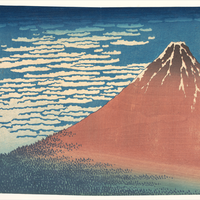More about Utagawa Kuniyoshi
- All
- Info
- Shop

Contributor
Utagawa Kuniyoshi is one of the most recent masters of the ukiyo-e woodblock print form.
He composed his work right at the end of the Edo period in Japan; if the Edo period was a high school dance, Kuniyoshi was a pounding, raucous anthem, sending everyone home sweating. He worked in all the major ukiyo-e subjects, producing around 20,000 works!
In Edo-era Japan, people would sometimes receive different names based on social roles, mirroring the customs of the indigenous Ainu people, who give specific time-bound names to children to protect them from spirits. Kuniyoshi was born Magosaburo in a place located near what is now Nihonbashihoncho, Tokyo, and, later in his youth, became Yoshisaburo. At the age of seven, he copied the work of Kitao Shigemasa and Kitao Masami. As he grew up, he digested pictures by Katsukawa Shun'ei and Katsukawa Shuntei, and became apprentice to Utagawa Tokoyuni. Three years later, Tokoyuni gave the artist his professional name: Utagawa Kuniyoshi. As a middle aged man, Kuniyoshi resided in Mukojima, churning out masterful works at turbo speed. He loved one of his cats so much that when it died, he buried it on the grounds of a temple and built a Buddhist altar for it.
I can't do justice to his brilliance without making a small list of his works, so I'll just point to some objectively awesome ones: his Kikai Whale (山海名産尽 紀州鯨, Kitakyushu City Museum of Art) shows a scene with an honesty rare in European art: a mother walks along the beach in tall geta shoes with a baby strapped to her, breasts out for easy feeding, and two children by her side. Kuniyoshi's satire shines in his triptych Minamoto Yorimitsu in Bed, Haunted by the Earth Spider and his Demons, in which a host of supernatural beings, or yōkai, including a giant spider on the right, a paper lantern with arms, a tiger, and a frog with a sword on the left, apparently serve as a metaphor for the chaotic political situation around the artist. Censors destroyed this work, but Kuniyoshi escaped scot-free, because nobody could prove that he mustered the yōkai as political operatives. Perhaps the most wonderful of all, especially for all my Arcimboldo-holics out there (you know who you are), is the aptly titled self-portrait I'm scared and a nice person, or At first glance he's really fierce, but actually a gentle person, depicting about a baker's dozen naked men contorted into the shape of the artist's face and a gesturing hand.
Academic art historians tend to love the "problem of influence"—"who influenced who"—almost as much as Aaron Burr loved Alexander Hamilton, but it's a question that's just too enticing to drop. We can't usually prove whether someone influenced someone else, but, like all mystical questions, there's a reward for the faithful: if you go to google.jp, click on image search, and search for Kuniyoshi's name in Kanji, 歌川 國芳, you'll see an incredible array of genius unfold in front of you which is like a Rosetta Stone for comic books, video games, and animation, such as "Kubo and the Two Strings" by Laika animation studio. Directly situated in the ukiyo-e tradition, Kuniyoshi builds the pop culture of the next century by using the popular themes of militarism and magical fantasy, alternating between a loving, familiar treatment of animals, especially cats and fish, acting like humans, yōkai doing unbelievable, fantastic things, and fight after fight after fight, which, like today's pop culture, make combat look transcendental, ordinary, cartoonish, and eternal. His interpretations of a novel by Kyokutei Bakin, with its plot-defining magical orbs and crystals, would influence later works like "Dragon Ball," "Inuyasha," and the "Legend of Zelda" series.
Sources
- Emerson, David L. "Mythology in Children's Animation." Mythlore 38.1 (Fall/Winter 2019): 261-68.
- "山海名産尽 紀州鯨." Kitakyushu Municipal Museum of Art, http://www.kmma.jp/collection/utaga0202.html.
- Imai, Keisuke. "Utagawa Kuniyoshi is a master of caricatures." Town News, Jun. 6, 2019, https://www.townnews.co.jp/0304/amp/2019/06/06/483383.html.
- Mostow, Joshua S. Pictures of the Heart: The Hyakunin Isshu in Word and Image. Honolulu: University of Hawaii Press, 1996.
- Papp, Zilia. Anime and Its Roots in Early Japanese Monster Art. Kent, UK: Global Oriental, 2010.
- Papp, Zilia. Traditional Monster Imagery in Manga, Anime and Japanese Cinema. Kent, UK: Global Oriental, 2010.
- "The cats drawn by the genius Utagawa Kuniyoshi are cute." Bakumatsu Guide, Nov. 2015, https://bakumatsu.org/blog/2015/11/neko_ukiyoe.html/amp.
Featured Content
Here is what Wikipedia says about Utagawa Kuniyoshi

Utagawa Kuniyoshi (Japanese: 歌川 国芳, [ɯtaɡawa kɯɲiꜜjoɕi]; 1 January 1798 – 14 April 1861) was one of the last great masters of the Japanese ukiyo-e style of woodblock prints and painting. He was a member of the Utagawa school.
The range of Kuniyoshi's subjects included many genres: landscapes, women, Kabuki actors, cats, and mythical animals. He is known for depictions of the battles of legendary samurai heroes. His artwork incorporated aspects of Western representation in landscape painting and caricature.
Check out the full Wikipedia article about Utagawa Kuniyoshi

















